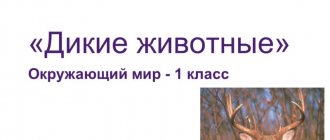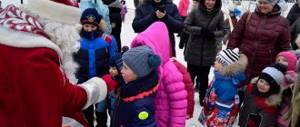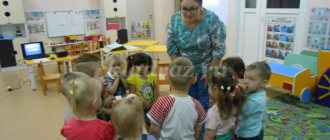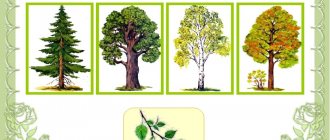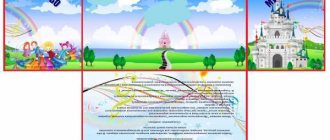LiveInternetLiveInternet
Quote from Tatyana57
Read in full In your quotation book or community!
SPEECH DEVELOPMENT. LEXICAL TOPIC “WILD BEASTS OF OUR FORESTS AND THEIR CHILDREN”
CHILDREN SHOULD KNOW THE NOUNS: bear, she-bear, bear cub, wolf, she-wolf, cub, hare, hare, little hare, fox, fox, fox, fox, hole, lair, squirrel, squirrel, hollow, moose, elk, calf, horns, hedgehog , hedgehog, hedgehog, wild boar, female boar, boar, badger, badger, little badger, forest, clearing, cheat, paw, wool, claws, nose, ears, hooves, tail. Muzzle, snout, mouth, animals, cubs, bushes, trees, mouse, lynx, raccoon, beaver, deer, marten, fangs, sable, mink, mole, den, connecting rod. ADJECTIVES: brown, clubfooted, cunning, predatory, gray, tireless, scary, thick (fur), red, wild, fluffy, dexterous, careful, fast, white, cowardly, long-eared, lop-eared, sensitive (ears), oblique, timid, velvet, prickly, wolf, striped. VERBS: wanders, climbs, roars, tears (bast), jumps, gallops, growls, grins. Hunts, escapes, howls, gnaws, digs, runs, “gave a go,” collects, stores, grunts, sniffs, sniffs, listens, hides, pricks, sneaks, sucks, lies down, falls. CHILDREN SHOULD BE ABLE TO NAME THE FAMILY: Bear, she-bear, little bear. Hare, hare, little bunny... SELECT NOUNS TO ADJECTIVES: Brown, club-footed, clumsy -... Gray, toothy, scary -... Cunning, fluffy, red-haired -... CALL MOM: The bear's cub, the fox's cub..., the bunny's... WHO HAS A VOICE : The fox yelps, the bear growls, the wolf howls... WHO LIVES WHERE: A fox lives in a hole. In the den - ... In the den - ... In the hollow - ... TO WHOM WE WILL GIVE WHAT: Meat - to the wolf, raspberries - ..., honey - ..., carrots - ..., nuts - ... SELECT NOUNS TO THE VERB: Hunts - ... Sneaks - ... Howls - ... Bites - ... Jumps - ... Tricks - ... Waddles - ... SELECT SIGNS: Wolf (which one?) -.... Fox (what?) - ... Hedgehog (what?) - ... SELECT ACTIONS: Bear (what is he doing?) - ... Fox (what is he doing?) - ... Hare (what is he doing?) - ... CORRECTLY ANSWERING THE QUESTIONS: Whose? WHOSE? WHOSE? WHOSE? Track - wolf, fox, hare... Ears - bear, hare, squirrel... Head - elk, hedgehog, wolf, fox... FORM NEW WORDS USING PRESIDENTS: Walks - moves, leaves, goes around, passes, enters, enters, descends, finds , leaves, approaches, reaches, comes, leaves, passes. COMPLETE A DESCRIPTIVE STORY ACCORDING TO PLAN. What is the name of? Where does he live? What kind of home does he have? What is the appearance? What habits? What does it eat? How does it get food? What are his enemies? How to defend yourself? What is the cub's name?
The fox is a predator. The fox mainly hunts mice, gophers, and less often hares. The fox cunningly catches hedgehogs. She rolls the hedgehog to the water, he straightens his spines in the water and swims to the shore. This is where the fox is waiting for him. The fox lives in a hole, and in the spring the fox gives birth to cubs. The squirrel is a rodent. She eats nuts, berries, mushrooms, and pine cones. The squirrel has sharp claws. This helps her quickly climb the tree. The fluffy tail serves as a parachute for the squirrel. A squirrel lives in a hollow and insulates its nest with down. In summer the squirrel is red, and in winter it is gray. In winter, the squirrel sleeps almost all the time and rarely looks out of the hollow. The squirrel is a thrifty housewife. She prepares nuts for the winter and dries mushrooms on tree branches. In the spring, squirrels give birth to squirrels. The wolf is a predatory animal. Wolves live in a pack. A pack is a wolf family. Wolves almost always hunt for sick, weak animals. Wolves hunt at night. Wolves live in a den to raise wolf cubs; wolf cubs appear in the spring. The bear is an omnivore. He loves to eat honey, berries, fish, ants, roots, but can also attack humans. The bear is clumsy in appearance, but easily climbs trees and runs quickly. The bear builds a den for himself from twigs, fallen trees, and moss. In winter, a mother bear gives birth to cubs. If a bear has accumulated little fat since the fall, it wakes up in the winter and walks through the forest hungry. For this the bear was nicknamed the connecting rod. The hare is a rodent. The hare feeds on grass, leaves, shrub bark, mushrooms, and roots. In winter, it chews the bark of trees. The hare is white in winter and gray in summer. This helps him hide from predators. Long, fast legs also save the hare from its enemies. The hare runs up the mountain at a run, and down the mountain somersaults. The hare lives under a bush in the summer, and digs a hole in the snow in the winter. In the spring, the hare gives birth to baby hares.
EXERCISE “GUESS AND TELL”. This beast lives in the forest, gnaws the bark of the trunks. In the summer in a gray fur coat, and in the winter in a white one. (Hare) - What does the hare eat in the spring? (grass, leaves). The owner of the forest wakes up in the spring, and in winter, to the howl of a blizzard, he sleeps in a snowy hut. (Bear) -What does a bear eat? (roots, grass, beetles, mice, hares). You and I recognize the animal by these two signs: He wears a gray fur coat in the winter, and a red fur coat in the summer. (Squirrel) - What does a squirrel feed on? (cones, nuts). All winter between the Christmas trees I slept through a bag of needles. “F-f-f-f—stop sleeping, It’s time to get up!” (Hedgehog) - What does a hedgehog eat? (bugs, worms, mice). Gray and toothy. Howls on a rainy day: “Uh-uh...” (Wolf) - What food does a wolf eat? (meat - catches mice, hares, sheep). Fluffy tail, golden fur, lives in the forest, steals chickens in the village. (Fox) - Who else does the fox catch? (mice, hares).
Game activity - a journey about animals using ICT for children of the senior group of preschool educational institutions
Game activity “Journey to the world of wild animals of the middle zone” for children 5-6 years old
Author: Kovalchuk Valentina Nikolaevna. Educator. Kindergarten No. 90. City of Tyumen. Description of the material: The materials presented in the development can be used by preschool teachers in general and individually. Goal: Systematize children's knowledge about wild animals of the middle zone. Objectives: Expand and clarify children's ideas about nature.
Deepen children's understanding of wild animals in the middle zone. Improve the dialogical form of speech. To instill interest in fairy tales whose heroes are wild animals of the middle zone. Foster a respectful, caring attitude towards nature. Progress of the game
Presenter: I invite everyone to “Journey to the world of wild animals of the middle zone.” Host: There are many miracles in the great world: Isn’t it a miracle, a thoughtful forest With green grass and wild berries? The emerald shine of beetles' wings, the cloak of blue moths - Isn't it a miracle? G. Galina Presenter: We will find out what kind of animal is hidden in the depths of the forest by guessing the riddles.
Riddles
Say by the presenter or the children.
A picture with the answer is shown to the children, or a picture with the answer appears on the slides. What kind of forest animal is this that stands up like a post under a pine tree?
Who stands among the grass with ears larger than his head? (Hare) He looks like a shepherd. Every tooth is a sharp knife! He runs, baring his mouth, ready to attack the sheep. (Wolf) Fluffy tail, quick dexterity, Golden-red fur. If you're hungry, the cheating Chicken counts better than anyone else. (Fox) Little red animal jumping and jumping through the trees. He lives not on the ground, but on a tree in a hollow. (Squirrel) Clubfooted and big, He sleeps in a den in winter. In the summer he walks through the forest, picking raspberries in his mouth. Loves fish, ants, guess who they are? (Bear) Angry touchy lives in the wilderness of the forest. There are a lot of needles, but not one thread. (Hedgehog) From aspen and alder, In a quiet river backwater, Without a single nail, I will build a house without difficulty! (Beaver) V. Leonov
Very heavy and high knee-deep snow.
Not a deer, but he has horns, everyone calls him elk. (Moose) S. Chertkov
Less than a tiger, but a little more than a large red cat.
On the bitch she usually hides and waits for prey. Don’t be timid, but beware, In that forest where ... (lynx.) What kind of animal, of the mustelid family, is so similar to a bear cub? All shaggy, thick fur, brown - fawn color. Paws with long claws, Teeth as sharp as razors, An eternal tramp in life, And an excellent tree climber. Who, fierce and without fear, Well, of course... (wolverine.)
“Where, who lives?”
Host: You need to name the house in which the animal lives. Presentation slides are used. Children's answers: I am a wolf.
My home is a den. I'm a hare. My house is under a bush. I'm a fox. My home is a hole. I'm a squirrel. My house is a hollow. I'm a bear. My home is a den. I'm a hedgehog. My home is a mink. I'm a beaver. My home is a hut. I'm a moose. My home is the forest. I'm a lynx. My home is a den. Sedentary game “Recognize and name”
The driver stands in a circle with his eyes closed.
The children walk in a circle around him and say: Animals have gathered at the forest edge.
Everyone is doing a round dance as if by choice. Open your eyes! Guess who we are! Children pretend to be some kind of animal.
And the driver, opening his eyes, tries to guess what animal the children are portraying. The driver chooses in his place the one who, in his opinion, best portrayed the animal. “Who eats what?”
Children are given pictures of animals. (Or use presentation slides.) Wolves are predators. Their food is deer, elk, livestock, partridges and grouse, and sometimes hares. Hares are herbivores. The main diet is various types of grasses, twigs of shrubs, leaves, roots, tubers and berries. They raid the fields for oats, clover, beets, cucumbers and potatoes. In winter they gnaw the soft bark of young trees and are not averse to profiting from hay. The fox is a predator. Its diet includes small rodents, hares, roe deer, geese, wood grouse, fish, insects and their larvae. Plant food - fruits, fruits, berries, oats. Squirrels are omnivores. They eat various nuts, seeds, cereal grains, fruits, berries, and mushrooms. And they eat insects, their larvae, eggs and even chicks of small birds. Squirrels make provisions for the winter: acorns, mushrooms, nuts. In spring they feast on young buds and shoots. Bears are omnivores. They eat berries, acorns, nuts, roots, tubers and grass stems. The diet of bears includes insects (ants, butterflies), worms, lizards, frogs, rodents (mice, marmots, gophers, chipmunks) and fish. Hedgehogs are omnivores. They feed on insects, spiders, earthworms, lizards, poisonous snakes, frogs, mice and other small rodents, and bird eggs. The hedgehog's plant food includes moss, mushrooms, acorns, cereal seeds and any sweet berries. Beavers are herbivores. The diet includes the bark and shoots of trees (aspen, willow, poplar and birch), as well as various herbaceous plants (water lilies, egg capsule, iris, cattail, reed, etc.). Moose are herbivores. Their food is lichens, moss, branches of trees and shrubs, and herbaceous plants. The elk's favorite food is leaves of trees (rowan, aspen, birch, willow, bird cherry, buckthorn, ash and maple.) Plants include marigold, water lilies, egg capsules, and horsetails. Closer to autumn - cap mushrooms, berry sprigs of lingonberries, blueberries. The winter diet includes tree branches. Lynx is a predator.
Its diet includes fox, white hare, various rodents, squirrels, raccoons and birds. Also sometimes larger game: roe deer, deer, serenade, elk, wild boar. Livestock can also be prey. Outdoor game “At the bear in the forest”
“Name the babies”
The presenter shows the children pictures of adult animals or images of animals appear on the slides (You can introduce toy characters.) Presenter: Name the baby animals.
Who are they? “Name the fairy tale”
Presentation slides are used. Presenter: Based on the illustrations, name fairy tales whose heroes are wild animals of the middle zone. Host: What are the wild animals of the middle zone called in fairy tales? (Last slide with answers). Answers: Bear - Potapych, Toptygin, Mikhailo-Ivanovich, Mishutka, Owner, clubfoot.
Fox - Fox - sister, Lisafya Lisa Patrikeevna, gossip, cheat, liar. Hare - bunny - runaway, bunny, coward. Wolf - top - gray barrel, gray wolf. Hedgehog - a hedgehog. Beaver - Inquay Beaver. Questions and Answers
1. Animals molt in spring and autumn. What is this? Answer: Summer fur is much thinner and shorter, winter fur is thicker and more lush.
2. Which animals also change color? Answer: The hare has squirrels. In the squirrel, in summer the color is dominated by red, brown or dark brown tones; in winter - gray and black.
3. How do animals protect themselves from enemies? Answer: The wolf uses fangs and claws, the Hare quickly runs away from enemies and also falls on its back and hits the enemy with its hind legs. Squirrels run up and down a tree in a spiral, making stunning leaps onto other trees. Hedgehog - with prickly needles. 4. What helps a hare notice danger? Answer: Large, sensitive ears. What helps a hare run fast and jump far? Answer: Strong and long hind legs that are longer than the front ones. When jumping, the tracks of the hind legs are in front of the front ones. 5. Who is the hare afraid of? Answer: wolf, fox, lynx, hawk. 6. Divide animals into three groups: herbivores, omnivores, predators. Answer: Herbivores: Hares, moose, beavers. Omnivores: Squirrels, hedgehogs. Predators: Foxes, wolves, bears, lynxes. 7. Who hunts herbivores? Answer: Predators. 8. What are the benefits of predators? Answer: Predators hunt weak, sick animals. Not only herbivores, but also predators remain healthy and strong in the forest. 9. What helps the fox find mice under the snow? Answer: Good hearing and sense of smell. 10. Where will the fox go for food when he becomes completely hungry in the forest? Answer: Steal chickens and ducks from the nearest village. 11. How do wolves hunt? Answer: In packs. 12. Do hedgehogs eat milk? Answer: No - this is a myth. Milk is harmful to hedgehogs. Hedgehogs' bodies do not digest lactose. 13. What animals are rodents? Answer: Squirrels, chipmunks, beavers, mice, hamsters. 14. What destructive influence does man have on nature, including animals? Answer: Man cuts down forests, pollutes the air, pollutes water bodies, and also the reason is hunting and extermination of animals that, in human opinion, are harmful. 15. What wild animals of the Tyumen region are listed in the Red Book? Answer: An ordinary hedgehog, a brown hare, an ordinary beaver, a large jerboa.
16. What wild animals of the middle zone are depicted in I. Shishkin’s painting “Morning in a Pine Forest”? Answer: Bears.
Summing up the game
Presentation on the topic: Journey into the world of wild animals of the middle zone
We recommend watching:
Scenario of a game lesson in a senior group A complex game lesson in a senior group Summary of educational activities for speech development in the senior group of a kindergarten. Journey to the land of games Intellectual KVN for children of the senior group of kindergarten
Similar articles:
Summary of a game lesson in the senior group of a preschool educational institution on the topic: “Sights of the city”
Lesson - traveling by air in the senior group of kindergarten
Lesson “Travel with the Sun” in kindergarten in the senior group
Lesson “Journey to the world of toys” in kindergarten in the senior group
